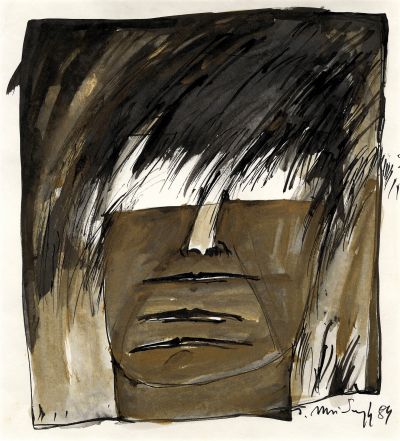Janina Musiałczyk. W drodze, on the road
Mediathek Sorted




































































































Musiałczyk’s teacher at the Academy of Fine Arts in Łódź, Stanisław Fijałkowski, had been a student of Strzemiński. He was also one of the most high-profile Polish painters of the 20th century, and for nearly 50 years was a lecturer, dean and professor at the Academy in Łódź as well as a visiting professor in Mons, Gießen and Marburg. During the 1960s, after an initial orientation towards Cubism, and influenced by the writings of Wassily Kandinsky, he developed a flat, abstract style, the clearly defined forms of which could also be perceived as abstracted objects in a poetical, transcendental reality.[40]
While Fijałkowski was also interested in Surrealism, in 1967, Musiałczyk wrote her diploma thesis under his guidance on a secondary aspect of art brut, the “The specific nature of naïve art”. While Dubuffet regarded art brut as being art by outsiders, since the mid-1960s, Naïve Art in the form of painting and wood carving by amateurs had become established at a high level in Poland, and later also gained traction as a recognised art movement in exhibitions throughout Europe. “Characteristic of naïve art”, Musiałczyk wrote, is “the presence of an idiosyncratic, self-generating, an original and intimate poetry, which is the emotional connection between the outer world and the world of intense inner emotional responses and experiences. In its images, there is an intensity of emotion that is relayed to the observer all the more in that it is not subject to an externally determined aesthetic and does without cultural references, while at the same time, its symbolism is elementary and readable. [...] Naïve art confounds through its lack of formulae and rules; it is an untamed art, the sole incentive of which is the deep need to produce in whatever way possible a picture of intense feelings, events, memories and dreams”.[41]
Musiałczyk also chose this “incentive” as the motto for her own art. Unlike her teacher, in her own independent work, she followed a figurative path, and in the broadest sense, her work could be ascribed to the New Figuration movement. She placed the human figure, as well as clearly definable objects such as houses, carts and landscape elements, in the centre of her images. With its focus on spiritual and existential human states, and its abstraction of objects, simplification of figures and their unusual gestures, her works most closely resemble the Nowa Figuracja that had become established in Poland during the 1960s, not only through the artists described above, but also as a result of the high-quality, unusually high-profile, Polish poster art of the time.
In the same year she completed her studies, she joined the Association of Polish Artists (Związek Polskich Artystów Plastyków, ZPAP) and participated in their exhibitions from that time on. From 1967, she also ran the group of studios dedicated to the fine arts in the Palace of Youth (Pałac Młodzieży) in Łódź, and in this capacity worked as an art teacher for children and adolescents. During her 14-year tenure as an art teacher, until her departure for Germany, she taught artists who would later become successful, including Marek Pabich, now Director of the Institute for Architecture and Urban Planning (Instytut Architektury i Urbanistyki) at Łódź Technical University (Politechnika Łódzka), the painter Dariusz Fiet, also a pupil of Fijałkowski, Iga Bielejec, who most recently worked as a book designer in Nierstein near Mainz, the Łódź-based graphic designer Małgorzata Misiowiec, the painter, object artist and photographer Tymoteusz Lekler, and restaurant owner Krzysztof Nast, who most recently worked at the Schloss Moyland Museum in Bedburg-Hau.[42]
In 1998, the painter Wojciech Leder, most recently the head of a painting studio and a professor at the Władysław Strzemiński Academy of Fine Arts in Łódź (Akademia Sztuk Pięknych im. Władysława Strzemińskiego w Łodzi), who was also a student of Fijałkowski, recalled the following at an exhibition by Musiałczyk in Hamburg: “I am lucky to have been a pupil of Janina Musiałczyk. She gave me guidance when I was at an age in which one is particularly susceptible to the world of illusions. After all, doesn’t our first contact with art take the form of carefully learning to imitate the way that nature appears to us?”[43]
According to the painter, performer, creator of animated films and professor at the Łódź Film School (Szkoła Filmowa w Łodzi), Mariusz Wilczyński, who also completed his diploma thesis under Fijałkowski: “The Palace of Youth (Pałac Młodzieży) was where I put all my energy. There, I met Darek Fiet, who later became an outstanding artist [...] or Marek Pabich, now a well-known professor of architecture. […] Janina Musiałczyk sparked a feeling in us that we were something special; we felt like Cézanne, Matisse or Renoir […]. At that time, we felt a huge compulsion, huge passion. That was the great achievement of Janina Musiałczyk, our painting and drawing teacher in the Pałac Młodzieży”.[44]
[40] Stanisław Fijałkowski: “4/8/66”, 1966, oil on canvas, 30 x 23 cm; “22 I 68–69”, 1968, oil on canvas, 72 x 59,5 cm; both National Museum in Warsaw (Muzeum Narodowe w Warszawie).
[41] Janina Musiałczyk: Specyfika malarstwa naiwnych (The specific nature of naïve art), Diploma thesis, Akademia Sztuk Pięknych im. Władysława Strzemińskiego, Łódź 1967, page 6 f.
[42] See also the recollections of Musiałczyk’s work as an art teacher by Nast, Misiowiec, Pabich and Piotr eL. (Częstochowa) below in the appendix to this text.
[43] Wojciech Leder: Unpublished essay on the occasion of the exhibition Janina Musiałczyk. “Pen Strokes for Today, Layers of Colour for Yesterday” (Federstriche für Heute, Farbschichten für Gestern), Künstlerhaus Hamburg-Bergedorf, 10.2.1998.
[44] Jerzy Armata: Z Armatą na Wilka. Animowany blues Mariusza Wilczyńskiego, Warsaw 2011, page 33 f.





















































































